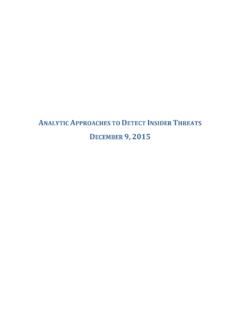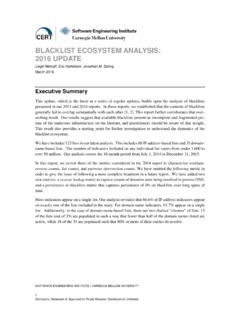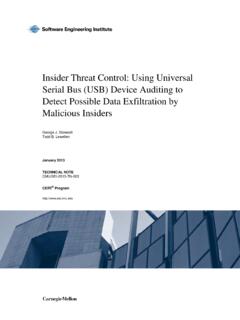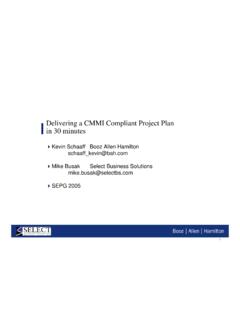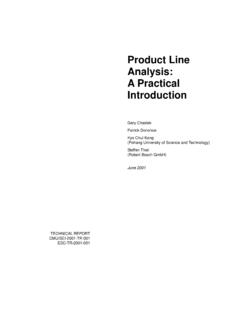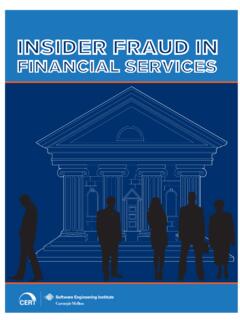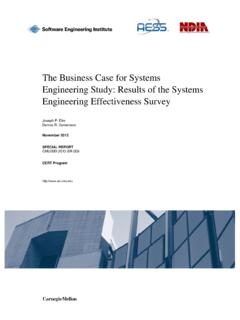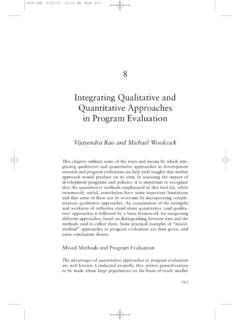Transcription of Quantitative Methods for Software Selection and Evaluation
1 Quantitative Methods for Software Selection and Evaluation Michael S. Bandor September 2006 Acquisition Support Program Unlimited distribution subject to the copyright. Technical Note CMU/SEI-2006-TN-026 This work is sponsored by the Department of Defense. The Software Engineering Institute is a federally funded research and development center sponsored by the Department of Defense. Copyright 2006 Carnegie Mellon University. NO WARRANTY THIS CARNEGIE MELLON UNIVERSITY AND Software ENGINEERING INSTITUTE MATERIAL IS FURNISHED ON AN "AS-IS" BASIS. CARNEGIE MELLON UNIVERSITY MAKES NO WARRANTIES OF ANY KIND, EITHER EXPRESSED OR IMPLIED, AS TO ANY MATTER INCLUDING, BUT NOT LIMITED TO, WARRANTY OF FITNESS FOR PURPOSE OR MERCHANTABILITY, EXCLUSIVITY, OR RESULTS OBTAINED FROM USE OF THE MATERIAL.
2 CARNEGIE MELLON UNIVERSITY DOES NOT MAKE ANY WARRANTY OF ANY KIND WITH RESPECT TO FREEDOM FROM PATENT, TRADEMARK, OR COPYRIGHT INFRINGEMENT. Use of any trademarks in this report is not intended in any way to infringe on the rights of the trademark holder. Internal use. Permission to reproduce this document and to prepare derivative works from this document for internal use is granted, provided the copyright and No Warranty statements are included with all reproductions and derivative works. External use. Requests for permission to reproduce this document or prepare derivative works of this document for external and commercial use should be addressed to the SEI Licensing Agent.
3 This work was created in the performance of Federal Government Contract Number FA8721-05-C-0003 with Carnegie Mellon University for the operation of the Software Engineering Institute, a federally funded research and development center. The Government of the United States has a royalty-free government-purpose license to use, duplicate, or disclose the work, in whole or in part and in any manner, and to have or permit others to do so, for government purposes pursuant to the copyright license under the clause at For information about purchasing paper copies of SEI reports, please visit the publications portion of our Web site ( ).
4 Contents v vii 1 Software Package 1 Initial 1 Evaluation Criteria .. 4 Intangible 4 5 2 Evaluation 7 Decision Analysis 7 Scoring 8 3 Conclusion .. 10 11 CMU/SEI-2006-TN-026 i ii CMU/SEI-2006-TN-026 List of Tables Table 1: Approaches for Conducting the Initial Market 2 Table 2: Vendor Self- Evaluation Scale 3 Table 3: Examples of Intangible 4 Table 4: Decision Analysis Spreadsheet: Example 7 Table 5: Decision Analysis Spreadsheet: Example 8 Table 6.
5 Example Legend for Scoring 9 CMU/SEI-2006-TN-026 iii iv CMU/SEI-2006-TN-026 Acknowledgments I would like to thank the following Software Engineering Institute (SEI) personnel for their assistance in reviewing and producing this technical note: Mary Ann Lapham, Harry Levinson, Bud Hammons, Linda Levine, Suzanne Couturiaux, and John Foreman. CMU/SEI-2006-TN-026 v vi CMU/SEI-2006-TN-026 Abstract When performing a buy analysis and selecting a product as part of a Software acquisition strategy, most organizations will consider primarily the requirements (the ability of the product to meet the need) and the cost.
6 The method used for the analysis and Selection activities can range from the use of basic intuition to counting the number of requirements fulfilled, or something in between. The Selection and Evaluation of the product must be done in a consistent, quantifiable manner to be effective. By using a formal method, it is possible to mix very different criteria into a cohesive decision; the justification for the Selection decision is not just based on technical, intuitive, or political factors. This report describes various Methods for selecting candidate commercial off-the-shelf packages for further Evaluation , possible Methods for Evaluation , and other factors besides requirements to be considered.
7 It also describes the use of a decision analysis spreadsheet as one possible tool for use in the Evaluation process. CMU/SEI-2006-TN-026 vii viii CMU/SEI-2006-TN-026 1 Software Package Selection Many organizations are attempting to save costs by integrating third-party, commercial off-the-shelf (COTS) packages ( , component libraries or extensions) or complete COTS-based solutions ( , enterprise resource planning [ERP] applications).
8 The Methods used to identify a set of possible candidate solutions are, for the most part, rather subjective. The individual or individuals performing the Evaluation have various, distinct experiences that will factor into the decision process, either consciously or subconsciously. To have a successful COTS Evaluation , a formal process is needed to properly evaluate COTS products and vendors supplying them [SEI 05]. In this instance, the term formal means having an established and documented process to perform the Selection and Evaluation activities in a consistent, repeatable manner. Initial Selection How does an organization conduct the initial research into products that might be candidates for use on their project?
9 How is the initial Selection performed? Some organizations use an intuitive approach to select the initial list of products. This approach uses an individual who has had past experience with the product or who has heard good things about the product. An inappropriate Selection strategy for COTS products can lead to adverse effects. It could result in a short list of COTS products that may not be able to fulfill the required functionality; in addition, it might introduce overhead costs in the system integration and maintenance phases [Leung 02]. One successful method for selecting products is the use of a Selection team.
10 When selecting a COTS component,1 the use of a team of technical experts systems/ Software engineers and several developers is recommended. When selecting a COTS-based system,2 however, the inclusion of business domain experts and potential end users is recommended [Sai 04]. The use of a team virtually eliminates a single-person perspective or bias and takes into account the viewpoints and experiences of the evaluators in the Selection and Evaluation process. Table 1 describes several approaches that can be used to conduct the initial market research. 1 A COTS component, in this context, would be something like a third-party graphics library or report generation tool.
